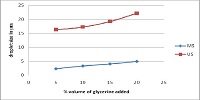Effect of Ultrasonication on Stability of Oil in Water Emulsions
Keywords:
Liquid paraffin, Tween 20, Span 20, emulsification, ultrasound technique, volume fraction of dispersed phaseAbstract
Effect of ultrasonic waves on stability of oil in water system of light liquid paraffin oil (HLB = 12) as internal phase and tween20 (HLB = 16.7), span20 (HLB = 8.6) as emulsifying agents was studied. A comparison was made to determine the stability of emulsions prepared by mechanical agitation method and ultrasonication technique. Droplet size measurement method was used to determine the stability of emulsions. Physico-chemical parameters like concentration of emulsifying agent, volume fraction of dispersed phase, viscosity of continuous phase by adding glycerin to water were compared apart from the effect of emulsification time on stability of emulsions prepared with mechanical stirring and ultrasound. Ocular micrometer was used to determine the droplet size of the dispersed phase. Emulsions prepared by ultrasonic technique were found to be more stable for longer duration of time when compared to emulsions prepared by mechanical agitation which can be attributed to the small droplet size which is thermodynamically stabilized. Ultrasonic technique gave more stable emulsions than with mechanical agitation method. Emulsification time, volume fraction of dispersed phase, viscosity of continuous phase and concentration of emulsifying agents played a major role in the stability of emulsions.
References
Abismal B, Canselier JP, Wilhelm AM,
Delmas H, Gourdon C. Emulsification by
ultrasound: drop size distribution and
stability. Ultrasonics Sonochemistry.
;6:75–83.
Tal-Figiel B. The formation of stable w/o,
o/w, w/o/w cosmetic emulsions in an
ultrasonic field. Trans I Chem E Part A:
Chemical Engineering Research and
Design 2007;85(A5):730–734.
Behrend O, Ax K, Schubert H. Influence
of continuous phase viscosity on
emulsification by ultrasound. Ultrasonics
Sonochemistry. 2000;7:77–85.
Behrend O, Schubert H. Influence of
hydrostatic pressure and gas content on
continuous ultrasound emulsification by
ultrasound. Ultrasonics Sonochemistry.
;8:271–276.
Higgins DM, Skauen DM. Influence of
power on quality of emulsions prepared by
ultrasound. J. Pharm. Sci.
;61(10):1567–1570.
Abismail B, Canselier JP, Wilhelm AM,
Delmas H, Gourdon C. Emulsification
processes: On-line study by multiple light
scattering measurements. Ultrason.
Sonochem. 2007;7:187–192.
Shashank G. Gaikwad, Aniruddha B.
Pandit. Ultrasound emulsification: Effect
of ultrasonic and physicochemical
properties on dispersed phase volume and
droplet size. Ultrasonics Sonochemistry.
;15:554–563.
Cucheval A, Chow RCY. A study on the
emulsification of oil by power ultrasound.
Ultrasonics Sonochemistry. 2008;15:916–
Leong TSH., Wooster TJ., Kentish SE,
Ashokkumar M. Minimising oil droplet
size using ultrasonic emulsification.
Ultrasonics Sonochemistry. 2009;16:721–
Ratjika Chanamai, John N. Coupland,
Julian McClements D. Effect of
temperature on the ultrasonic properties of
oil-in-water emulsions. Colloids and
Surfaces A: Physicochemical and
Engineering Aspects. 1998;139:241–250.
Tharwat Tadros. Application of rheology
for assessment and prediction of the longterm physical stability of emulsions.
Advances in Colloid and Interface
Science. 2004;10:227–258.
Lizarraga MS., Pan LG., Anon MC.,
Santiago LG. Stability of concentrated
emulsions measured by optical and
rheological methods. Effect of processing
conditions—I. Whey protein concentrate.
Food Hydrocolloids. 2008;22:868–878.
Guoxiang Ye, Xiaoping Lua, Pingfang
Hana, Fei Peng, Yanru Wang, Xuan Shen.
Application of ultrasound on crude oil
pretreatment. Chemical Engineering and
Processing. 2008;47:2346–2350.
Gogate PR. Cavitational reactors for
process intensification of chemical
processing applications: a critical review.
Chemical Engineering and Processing.
;47(4):515–527.
Tal-Figiel B. The formation of stable
W/O, O/W, W/O/W cosmetic emulsions in
an ultrasonic field. Chemical Engineering
Research and Design. 2007;85(A5):730–
Solans C, Izquierdo P, Nolla J, Azemar N,
Garcia-Celma MJ. Nano-emulsions.
Current Opinion in Colloid and Interface
Science. 2005;10:102–110.
Tadros T, Izquierdo R, Esquena J, Solans
C. Formation and stability of nanoemulsions. Advances in Colloid and
Interface Science. 2004;108–109:303–
Sonneville-Aubrun O, Simonnet JT,
Alloret FL. Nanoemulsions: A new
vehicle for skincare products. Advances in
Colloid and Interface Science. 2004;108–
;145–149.
Nohynek GJ, Lademann J, Ribaud C,
Roberts MS. Grey goo on the skin?
Nanotechnology, cosmetic and sunscreen
safety. Critical Reviews in Toxicology.
;37(3):251–277.
Schifone M, Zadeh HS. Cosmetic
nanoemulsions. Cosmetic Technology.
;9(7):27–31.
Kentish S, Wooster TJ, Ashokkumar M,
Balachandran S, Mawson R, Simons L.
The use of ultrasonics for nano-emulsion
preparation. Innovative Food Science and
Emerging Technologies. 2008;9:170–175.
Wooster TJ, Sanguansri P, Golding M.
Impact of oil type on nanoemulsion
formation and Ostwald ripening stability.
Langmuir. 2008;24(22):12758–12765.
Gopal ESR. Principles of emulsion
formation, in: P. Sherman (Ed.), Emulsion
Science, Academic Press, New York,
;pp. 1–75.
Karbstein H, Schubert H. Developments in
the continuous mechanical production of
oil-in-water macro-emulsions. Chemical
Engineering and Processing.
;34:205–211.
Pandit AB, Joshi JB. Hydrolysis of fatty
oils by cavitation. Chemical Engineering
Science. 1993;48(19):3440–3442.





